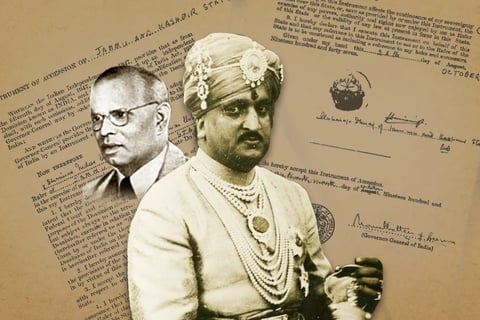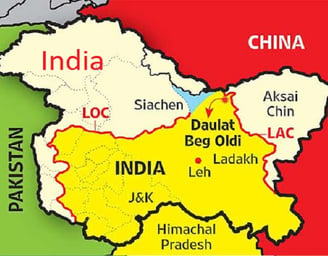Kashmir Series Part 1: The Partition, the Princes, and the Price of Division
Explore the origins of the Kashmir conflict in Part 1 of our Kashmir Series. From the 1947 partition to the accession drama between Nehru, Jinnah, and Maharaja Hari Singh, discover how it all began.
MISCELLANEOUS
Deepita
5/11/20254 min read


“Midnight’s children were born in chaos.”
August 15, 1947 — the day two nations emerged from one. India and Pakistan were carved out of the same soil, but with different visions, leaders, and destinies. What many thought would be a moment of celebration became a blood-soaked beginning.
But in this storm of partition, one land stood undecided. One kingdom hung in the balance — Jammu & Kashmir.
The Partition and the Princely Dilemma
When the British left in 1947, they handed princely states a rare and risky freedom: to choose their destiny. Over 565 kingdoms across the subcontinent were given three options — join India, join Pakistan, or remain independent.
Most made their decisions swiftly, guided by geography, religion, or political pressure.
But one ruler stood at the crossroads longer than most — Maharaja Hari Singh, the Dogra monarch of Jammu & Kashmir.
He ruled over a breathtakingly beautiful state with a Muslim-majority population, yet he himself was a Hindu king. Caught between two rising giants and a storm of communal tensions, Hari Singh dreamt of something rare — an independent Kashmir. A Switzerland in the Himalayas. Neutral. Untouched.
But history had other plans.
Nehru, Jinnah, and a Land of Longing
At the heart of Kashmir’s fate stood two towering figures — Jawaharlal Nehru and Muhammad Ali Jinnah — each with dreams for their newborn nations, and each with claims—emotional or ideological—on the land of Kashmir.
For Nehru, Kashmir was not just territory. It was personal. His roots traced back to the lush valleys, his lineage entwined with the land as a Kashmiri Pandit. He imagined India as a secular sanctuary, where all religions could coexist — and Kashmir, with its Muslim majority and Hindu ruler, was to be its living symbol.
Jinnah, the architect of Pakistan, saw things differently. To him, the logic was clear: Kashmir was Muslim-majority — it rightfully belonged to Pakistan. His vision for Pakistan was rooted in safeguarding Muslim identity, and Kashmir was a piece that fit the puzzle of Partition.
But where diplomacy should have built bridges, mistrust and miscalculation drew lines in blood.
What could have been a negotiation became a collision of national pride, politics, and fear.
The people of Kashmir were caught in a tug-of-war — not of their choosing, but one that would define generations.
The Invasion & The Instrument of Accession
October 22, 1947 — chaos came crashing through the serene valleys of Kashmir.
Thousands of tribal militias, backed secretly by Pakistan’s military, stormed the region from the northwest. What started as an incursion quickly turned into a massacre. Villages were looted. Homes were torched. Women and children fled into the forests. Blood soaked the snow.
Maharaja Hari Singh, who had dreamt of an independent Kashmir, now watched his kingdom fall apart. Desperate and overwhelmed, he turned to India for help.
But India had a condition:
If its soldiers were to defend Kashmir, the state had to formally join the Indian Union.
And so, on October 26, 1947, with his back against the wall, the Maharaja signed the Instrument of Accession. Kashmir legally became a part of India — at least on paper.
The very next day, Indian troops were airlifted into Srinagar in a bold military operation. Fierce battles followed. Thus began the First India-Pakistan War — not just over territory, but over identity, allegiance, and a people caught in the firestorm of history.
The World Intervenes: Ceasefire and the Line That Cut Kashmir
By late 1948, the mountains of Kashmir had become graveyards. The first war between India and Pakistan reached a brutal deadlock. Villages lay in ruins. Families were torn between borders and bullets.
India turned to the global stage and appealed to the United Nations, hoping diplomacy could end what guns could not.
On January 1, 1949, under mounting international pressure, a ceasefire was declared.
But peace came with a price — a new wound carved into the land: the Line of Control (LoC).
Kashmir was split.
One half administered by India, the other by Pakistan.
The valley — once whole — was now divided by barbed wire, mistrust, and generations of grief.
The UN proposed a plebiscite — a public vote — to let Kashmiris decide their own fate.
But that promise remains unfulfilled, suspended in diplomatic deadlock and national agendas.
The war had ended.
But the story — and the suffering — had only just begun.
A Legacy of Division
And so, Kashmir’s fate was not chosen — it was cornered.
A hurried signature on a cold October night.
A war waged by two nations barely a year old.
And a paradise split in half — not by the will of its people, but by fear, politics, and power.
The Line of Control became more than just a boundary.
It became a wound that never truly healed.
A place where memories, families, and futures stood divided.
But this was not the end.
This was the prologue — to decades of conflict, rebellion, hope, betrayal, and resilience.
The story of Kashmir had only just begun.
Turn the Page with Us:
If this story moved you, share it.
Follow the series for Part 2, where we dive into Kashmir’s post-accession politics and the seeds of rebellion.
Let’s understand the past—because only then can we shape the future.






